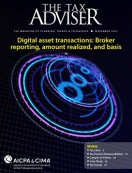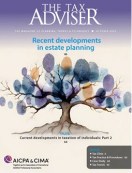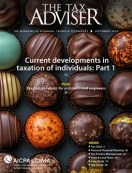- newsletter
- TAX INSIDER
The close of deferral: Planning for the QOZ end game
Many investors in qualified opportunity zones face a large upcoming tax hit when their QOZ deferral ends.

Related
IRS clarifies health savings account changes in H.R. 1 in new notice
Government withdraws defense of retirement fiduciary rule
IRS outlines details for Trump accounts
What do you do when the proverbial “tax man” is coming to collect on tens of billions of deferred gains? As part of the 2017 Tax Cuts and Jobs Act,1 Congress established the qualified opportunity zone (QOZ) program to provide federal income tax incentives2 for investment in certain economically distressed communities. Investors who reinvested capital gains into a qualified opportunity fund (QOF) and met certain requirements were afforded tax deferral on these capital gains until the earlier of (1) Dec. 31, 2026, or (2) the date that the investment in the fund is disposed of.
Tax and financial advisers helped investors defer tens of billions of dollars of capital gains under the QOZ program, knowing that the gains must be recognized at the end of the deferral period and an end game must be considered. As the “day of reckoning” quickly approaches for many investors when these gains can no longer be deferred, systematically accumulating capital losses in advance of this recognition event may help to alleviate the forthcoming tax hit and mitigate potential liquidity concerns.
Paying the piper
Capital gains that are deferred through reinvestment in a QOF are not deferred indefinitely and maintain their original tax character (e.g., short-term capital gain, long-term capital gain). QOZ investors will be subject to whatever capital gains tax rates are in effect in the year of inclusion.
Some investors may also face cash-flow issues in the year of inclusion since capital gains must be recognized even though they may not receive any cash to help pay the taxes.
How many billions in QOZs are we talking here?
According to a 2023 U.S. Department of the Treasury tax analysis,3 the total amount of capital gains deferred by investing in QOFs and electronically reported to the IRS on Form 8997, Initial and Annual Statement of Qualified Opportunity Fund (QOF) Investments, was approximately $27 billion in 2019. This amount increased to $39 billion in 2020. It’s possible that total deferred capital gains have increased since 2020.

According to the same Treasury analysis, 2020 individual investors in QOFs tended to be higher-income households, with a median adjusted gross income (AGI) of approximately $730,000 and median deferred gains invested in a QOF of approximately $250,000. On average, entities (including corporations, partnerships, and estates and trusts) made larger investments in QOFs, averaging about $4 million.
With all these anticipated gains coming up, what steps can taxable investors take to mitigate the tax bite?
Harvesting capital losses to offset QOZ gains
Taxable investors frequently seek to reduce their overall tax burden and boost after-tax returns by selling securities that have declined in value, a strategy known as “tax-loss harvesting.”4 Such a methodical accumulation of capital losses may be used to offset capital gains that were previously deferred under the QOZ program.
For individual investors, capital losses may offset capital gains and up to $3,000 of ordinary income on a federal income tax return.5 Excess capital losses carry forward6 and may be used to offset capital gains in future tax years, including future QOZ capital gains.
Turning to which assets work best for loss harvesting, individual stocks may present greater opportunities for loss harvesting than bonds, equity mutual funds, or equity exchange-traded funds (ETFs), due to greater volatility and wider distributions of investment returns. Accordingly, tax-loss harvesting with individual stocks in a separately managed account (also known as “direct indexing”) may boost overall loss-harvesting opportunities.
Employing margin and shorting in a tax-managed public equity long-short strategy7 may further boost opportunities to harvest losses while adhering to an investor’s pretax investment thesis. In such a long-short strategy, the use of leverage increases the overall gross exposure by introducing margin long exposures and short exposures, augmenting opportunities to loss-harvest both on the long and short side, in both upward- and downward-trending markets.
For example, the exposures in a long-only strategy are 100% long and 0% short. In a 140/40 long-short portfolio, the use of leverage increases exposures to 140% long and 40% short. For every $100 invested, the gross exposure of a 140/40 strategy is $180.
Loss harvesting in advance of QOZ gains
Although most of the benefits of tax-loss harvesting are delayed until individual investors have capital gains available to absorb the losses, accumulating losses in advance of QOZ or other upcoming gain recognition events over multiple years may allow such investors to offset considerably more capital gains than if systematic loss harvesting occurs only in the year of the recognition event.8
Stockpiling losses ahead of expected future gain recognition events tends to be more advantageous when losses will offset short-term capital gains or the portfolio will be contributed to charity or passed through an estate.
Conclusion
Although much has been written about the QOZ program and related tax incentives, little attention has been given to planning for the end of the deferral period. Well, here we are. Under current law, tens of billions of dollars of previously deferred capital gains under the QOZ program must be recognized over the next few years. Implementing a loss-harvesting program in advance of this recognition event may help to offset some or all of these gains and mitigate the impending tax hit.
Should future legislation extend the deferral period, the extension would likely boost the quantity of capital losses that could be harvested before such a recognition event.
Although a loss-harvesting strategy can be very powerful in certain situations, it may not be appropriate in all circumstances, and advisers can assist their clients in analyzing the potential merits and risks.
— Lincoln Fleming, CPA/PFS, CFP, M.Acc., is a director and after-tax wealth strategist at BlackRock. To comment on this article or to suggest an idea for another article, contact Paul Bonner at Paul.Bonner@aicpa-cima.com.
Footnotes
1P.L. 115-97, enacted December 2017.
2Investment in a QOF provides investors with three potential sources of federal tax incentives:
- Limited tax deferral: An investor may elect to defer all or a portion of a realized capital gain by reinvesting the amount of the gain into a QOF within 180 days from the date of the sale. The deferral is effective until the earlier of (1) Dec. 31, 2026, or (2) the date that the investment in the fund is disposed of.
- Partial step-up in tax basis of deferred gains: Investors may exclude 10% of the original deferred gain from taxation after holding the QOF investment for five years. An additional 5% may be excluded once a seven-year holding period is reached. Opportunity zone investors must have invested prior to Jan. 1, 2022, to receive any benefit from this incentive.
- No tax on QOF appreciation: Investors who reinvested capital gains into a QOF between 2018 and 2026 and hold their interest for at least 10 years may sell their investment prior to 2048 and exclude any gain from the sale.
Note that some states may not conform to the federal tax rules or may have their own opportunity zone programs.
3See Coyne and Johnson, “Use of the Opportunity Zone Tax Incentive: What the Data Tell Us,” Office of Tax Analysis Working Paper 123 (July 2023).
4See Fleming, “The Economics of Tax-Loss Harvesting,” 54-9 The Tax Adviser 42 (September 2023).
5See Sec. 1211. The $3,000 threshold is reduced to $1,500 in the case of a married individual filing a separate tax return.
6Excess capital losses may be carried forward indefinitely during an individual taxpayer’s lifetime. See Sec. 1212(b).
7A full discussion of the tax issues to consider when implementing a long-short strategy, such as the straddle rules, constructive sale rules, and the economic substance doctrine, is beyond the scope of this article.
8See Fleming and Cai, “The Time Value of Capital Losses,” 55-10 The Tax Adviser 42 (October 2024).














